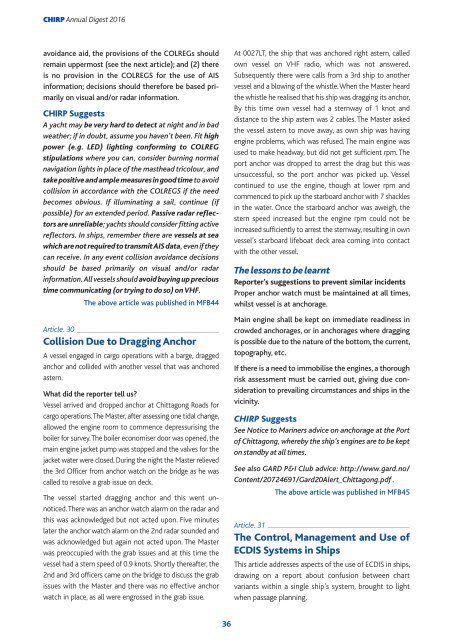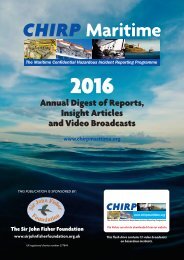CHIRP annual digest 2016 6th
Create successful ePaper yourself
Turn your PDF publications into a flip-book with our unique Google optimized e-Paper software.
<strong>CHIRP</strong> Annual Digest <strong>2016</strong><br />
avoidance aid, the provisions of the COLREGs should<br />
remain uppermost (see the next article); and (2) there<br />
is no provision in the COLREGS for the use of AIS<br />
information; decisions should therefore be based pri -<br />
marily on visual and/or radar information.<br />
<strong>CHIRP</strong> Suggests<br />
A yacht may be very hard to detect at night and in bad<br />
weather; if in doubt, assume you haven’t been. Fit high<br />
power (e.g. LED) lighting conforming to COLREG<br />
stipulations where you can, consider burning normal<br />
navigation lights in place of the masthead tricolour, and<br />
take positive and ample measures in good time to avoid<br />
collision in accordance with the COLREGS if the need<br />
becomes obvious. If illuminating a sail, continue (if<br />
possible) for an extended period. Passive radar reflec -<br />
tors are unreliable; yachts should consider fitting active<br />
reflectors. In ships, remember there are vessels at sea<br />
which are not required to transmit AIS data, even if they<br />
can receive. In any event collision avoidance decisions<br />
should be based primarily on visual and/or radar<br />
information. All vessels should avoid buying up precious<br />
time communicating (or trying to do so) on VHF.<br />
The above article was published in MFB44<br />
Article. 30<br />
Collision Due to Dragging Anchor<br />
A vessel engaged in cargo operations with a barge, dragged<br />
anchor and collided with another vessel that was anchored<br />
astern.<br />
What did the reporter tell us?<br />
Vessel arrived and dropped anchor at Chittagong Roads for<br />
cargo operations. The Master, after assessing one tidal change,<br />
allowed the engine room to commence depressurising the<br />
boiler for survey. The boiler economiser door was opened, the<br />
main engine jacket pump was stopped and the valves for the<br />
jacket water were closed. During the night the Master relieved<br />
the 3rd Officer from anchor watch on the bridge as he was<br />
called to resolve a grab issue on deck.<br />
The vessel started dragging anchor and this went unnoticed.<br />
There was an anchor watch alarm on the radar and<br />
this was acknowledged but not acted upon. Five minutes<br />
later the anchor watch alarm on the 2nd radar sounded and<br />
was acknowledged but again not acted upon. The Master<br />
was preoccupied with the grab issues and at this time the<br />
vessel had a stern speed of 0.9 knots. Shortly thereafter, the<br />
2nd and 3rd officers came on the bridge to discuss the grab<br />
issues with the Master and there was no effective anchor<br />
watch in place, as all were engrossed in the grab issue.<br />
At 0027LT, the ship that was anchored right astern, called<br />
own vessel on VHF radio, which was not answered.<br />
Subsequently there were calls from a 3rd ship to another<br />
vessel and a blowing of the whistle. When the Master heard<br />
the whistle he realised that his ship was dragging its anchor.<br />
By this time own vessel had a sternway of 1 knot and<br />
distance to the ship astern was 2 cables. The Master asked<br />
the vessel astern to move away, as own ship was having<br />
engine problems, which was refused. The main engine was<br />
used to make headway, but did not get sufficient rpm. The<br />
port anchor was dropped to arrest the drag but this was<br />
unsuccessful, so the port anchor was picked up. Vessel<br />
continued to use the engine, though at lower rpm and<br />
commenced to pick up the starboard anchor with 7 shackles<br />
in the water. Once the starboard anchor was aweigh, the<br />
stern speed increased but the engine rpm could not be<br />
increased sufficiently to arrest the sternway, resulting in own<br />
vessel’s starboard lifeboat deck area coming into contact<br />
with the other vessel.<br />
The lessons to be learnt<br />
Reporter’s suggestions to prevent similar incidents<br />
Proper anchor watch must be maintained at all times,<br />
whilst vessel is at anchorage.<br />
Main engine shall be kept on immediate readiness in<br />
crowded anchorages, or in anchorages where dragging<br />
is possible due to the nature of the bottom, the current,<br />
topography, etc.<br />
If there is a need to immobilise the engines, a thorough<br />
risk assessment must be carried out, giving due con -<br />
sideration to prevailing circumstances and ships in the<br />
vicinity.<br />
<strong>CHIRP</strong> Suggests<br />
See Notice to Mariners advice on anchorage at the Port<br />
of Chittagong, whereby the ship’s engines are to be kept<br />
on standby at all times.<br />
See also GARD P&I Club advice: http://www.gard.no/<br />
Content/20724691/Gard20Alert_Chittagong.pdf .<br />
The above article was published in MFB45<br />
Article. 31<br />
The Control, Management and Use of<br />
ECDIS Systems in Ships<br />
This article addresses aspects of the use of ECDIS in ships,<br />
drawing on a report about confusion between chart<br />
variants within a single ship’s system, brought to light<br />
when passage planning.<br />
36



